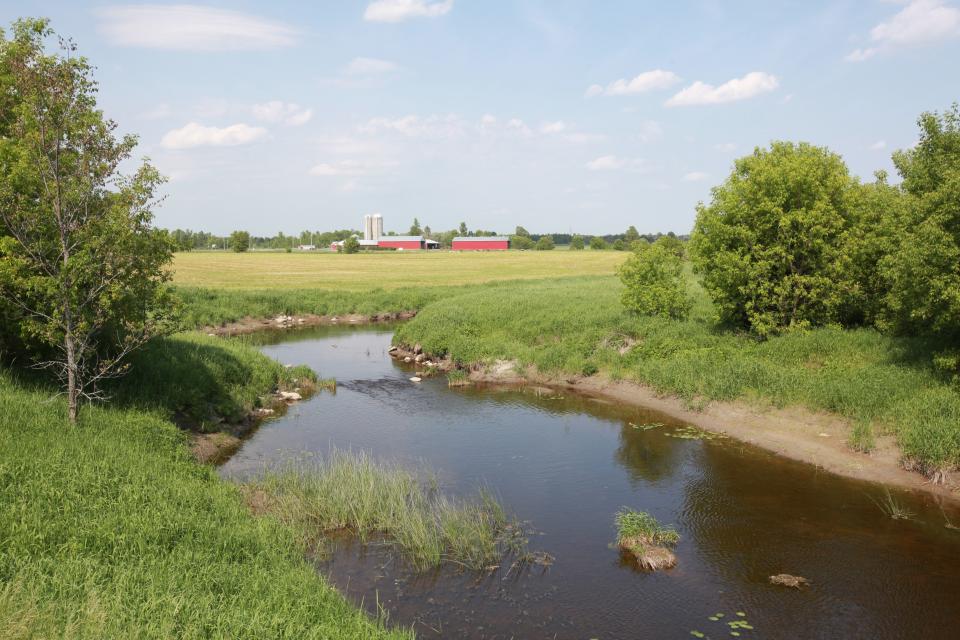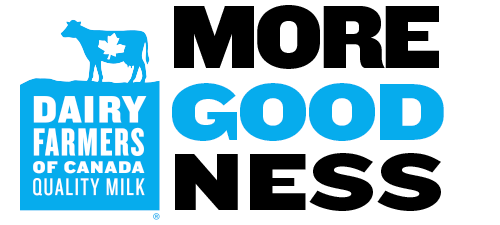Highlights
- A look at the proAction Environment module that came in effect in 2021.
- Canadian dairy farmers innovate to improve their environmental footprint. Between 2011 and 2021 , the carbon footprint of producing a litre of milk here decreased 9%.
Perhaps you have spotted it when enjoying your favourite food or beverage – the Dairy Farmers of Canada ‘Blue Cow’ logo, which makes it easy to identify products made with 100% Canadian milk and dairy ingredients.
When you buy products marked with the Blue Cow logo, you’re not just supporting the local economy and choosing milk from Canadian farms. Behind the logo is a robust quality assurance program called proAction®, which assures that Canadian milk is produced responsibly, under some of the world’s most stringent standards.
Farmers follow a comprehensive set of requirements and best practices in areas like milk quality, food safety, animal care, biosecurity, livestock traceability and environment which support the exceptional quality of Canadian milk. It also assures you, the consumer, that Canadian milk is produced responsibly by farmers who care!
The last module added to on-farm audits is the area of environment. Under this module, all farms are required to have an environmental farm plan in place. These highly tailored plans outline some of the specific measures that are taken on each individual farm. Even before the new module was introduced, more than 80% of dairy farms already had an environmental farm plan.
The module also includes a benchmarking aspect, to help farm operators identify areas of strength and opportunities for improvement. The data collected through this component will help provide a detailed pan-Canadian snapshot of farm-level actions over time.
Additional requirements aim to reduce the risk of contamination of soil, groundwater and surface water from wastewater and manure, and to make the best use of manure and other nutrients on the farm.
The environmental impact of milk
Producing a litre of milk in Canada already has one of the lowest carbon footprints in the world for dairy, and it is equivalent to less than half of the international average. And our farmers are not stopping there!
The latest life cycle assessment shows that between 2011 and 2021, the carbon footprint of producing a litre of milk on a Canadian farm went down 9% and now stands at 0.94 kg of CO2 equivalent. There are several factors contributing to this decrease, namely cow productivity. It takes about 65% fewer dairy cows to produce milk for all of Canada today than it did 50 years ago, despite the population growing demand. Improvements to cow comfort, feed efficiency and more have helped make Canadian dairy more productive.
What about water? Water plays an important role on dairy farms: it is needed to grow crops, keep cows cool and hydrated, and clean barns and equipment. Thanks to innovative water recycling technologies, Canadian dairy farmers have reduced their in-barn water consumption. However, as 2021 was a drought year, more farmers turned to irrigation to keep producing the feed cows needed. Growing crops needed 83% of the water consumed on dairy farms that year. On a per-litre basis, it was 31 litres of water consumed per litre of milk produced.
Between 2011 and 2021, Canadian dairy farmers reduced the amount of land needed to produce a litre of milk by 21%, through improved yields and land management practices. Practices include:
- Strategic crop rotations to improve soil health and improve biodiversity;
- Using the natural kind of fertilizer that is cow manure to foster microbial activity in the soil and reduce the need for petroleum-based fertilizers;
- The use of cover crops to help minimize soil erosion, increase fertility and moisture, and control against weeds, pests, and diseases while supporting biodiversity; and
- Adopting reduced or no tillage practices, like leaving stubs and roots of a previous year’s crop in the soil, to help capture more carbon in the soil.
Other measures being implemented on farms
A number of dairy farms have installed biodigesters, which convert the methane contained in manure into reusable energy, while continuing to use manure as a natural fertilizer. More are installing solar panels or wind turbines on their land, where the weather conditions are right for it.
Today, farmers are embracing GPS-enabled smart tractors, data collection, computerized models, robotic machinery, and other high-tech farming equipment to increase productivity and reduce their environmental footprint.
Protecting our environmental legacy is important to Canadian dairy farmers, and doing more with less means improving productivity, reducing waste, and managing resources responsibly.
Our work is not yet finished, as the proAction program will continue to evolve to reflect the latest research and best practices.
For more information, please visit dairyfarmers.ca/proaction.





